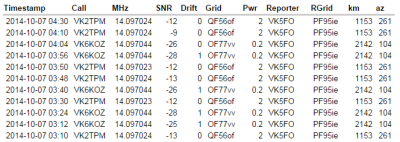WSPR or Weak Signal Propagation Reporter is something that I recently discovered and have started to realize just how this real-time data can be used as a part of all other radio activity.
First off, WSPR is a series of low power – usually between 100mW and 5W beacons that around 500 Amateurs all over the world run. A WSPR station is usually one where you both TX and RX, and when you RX, you upload your reports to the wsprnet site. Now the beauty of this is that with a little bit of know-how on how it all works, you get a brilliant insight into the probable HF Bands and opening in near-real time, no predictions here – all real-world, right now reports.
I won’t go into great details on how it all works, but instead, I’ll give just enough info so you can learn for yourself how to use this data.
First off, jump on the site and go to the map page. Here, select a band, and then take a look at both the 30 minute and 10 minute maps for each bands that are of interest. If there are lines on the map, it indicates either a TX or RX path – but more on that shortly.
Check out the stations that are closest to you, make a note of the callsigns of a couple of them . we will use these callsigns as search parameters in the database. Go to the database, and click the specify the query parameters link. Here, put the given callsign in both the call and reporter box, select the band and time to drill down on some data!

Now, at first look, it does not mean a lot, but within the data there is a wealth of information. Just take the very first line, and we can see the date/time the station that is sending the report, the Received Signal (SNR), Grid square they are sending from, the TX power of the beacon, and finally your details.
WSPR beacons are 110.5 seconds long and are a weak signal mode, and can detect signals down to about -30db below the RX noise and all of this info is really important in understanding how we can use this data.
Lets look at the specifics of the first line of data -12b, and a 2W beacon. To determine if this might be a workable path, we need to do some basic maths. Now, to get this signal up to say, 3db over the noise floor or 15db, we can look at the 2W and add 15db to it – and we come up with a power level of around 60W. So, if you have a typical 100W transmitter, it is highly probable you would have a working path! If you listen, you can often hear signals that are around -6db, so saying 3db over the noise is a reasonable estimate of what is probably workable via SSB.
Now, if we take a bit of time, look at the maps, see where there are a lot of paths between general areas (eg, 20M lots of lines to either US or EU), look at the actual reports, do a bit of basic maths, and voila!
Now, finally, how does this help with portable operations, such as SOTA. to tell the truth, exactly the same! You just need to look at potential paths but this time based on QRP power levels you will be running from a summit, and take into consideration, that usually the noise floor is a lot less – like 10 or more DB lower, which you can take into consideration!
So, what does this mean? Well, before I go out, I take a quick look at the maps, all the bands that appear to be open and to where and give them a shot – If there is an indication of a particular path being open, then it is worth giving it a go!
If even 2 or 3 regular SOTA activators in each association put up a WSPR station running about 1W on the more popular SOTA bands (40M – thru 10M ), then this would quickly become a valuable tool for both activators and chasers alike. Just think that if we had say even 2 40M stations in all VK states we would quickly develop a picture that we could then additionally cross-reference to what it showed compared to what was worked – further validating the usefulness.
To this end, I have built a dedicated 0.5W WSPR transmitter – the QRPLabs Ultimate 3 Kit and Currently testing it. Once I am happy with it, I will be installing the required antennas and putting it into service. I will be installing it at a remote (to me) location, and hopefully, with a handful of other VK RX WSPR stations, it will prove to be a useful resource for monitoring real-time and also long-term trends of propagation.
A RX station is easy – use any receiver that you can interface to your PC – heck even an SDR with a HF up-converter can be used. Some people have also reported success in running multiple SDR’s on different bands on the same PC.
Yeah, you could go and look at the numerous predictions, but is it not more fun to measure them yourself?
Stay tuned, once I get my beacon in place there will be more details, but for now, look up the WSPR frequencies, and see if you can RX my beacon – It can be found on all bands 40-10M and beacons 3 times per hour per band. At the moment, it is running into a vertical and I have only had a limited success, but another antenna system is in the works.

Hi Bob, nice to talk to you last night. I too have been researching this mode recently, and have been thinking about building the ultimate 3 as well. I will follow your progress.
Cheers Tim VK5AV.